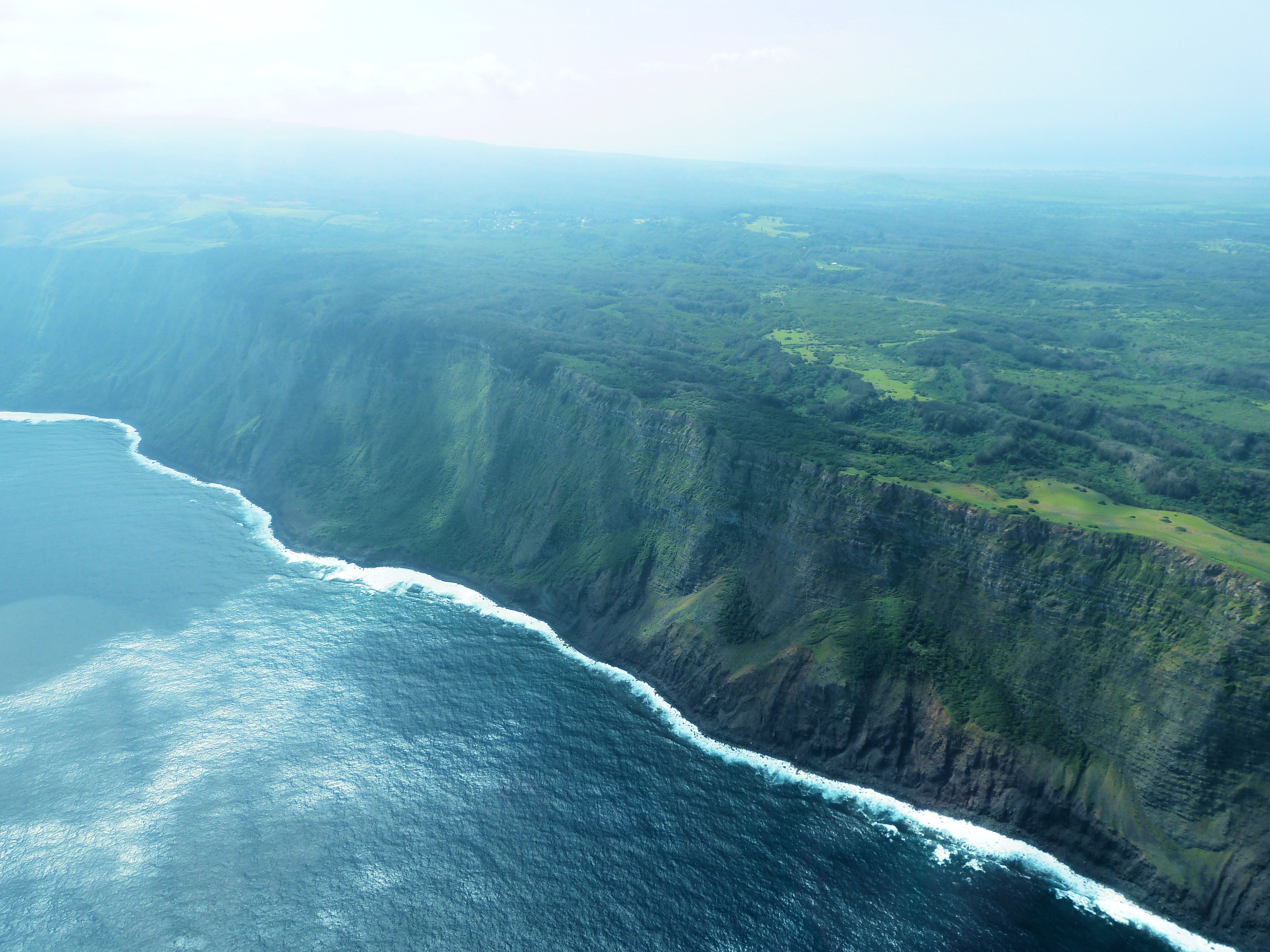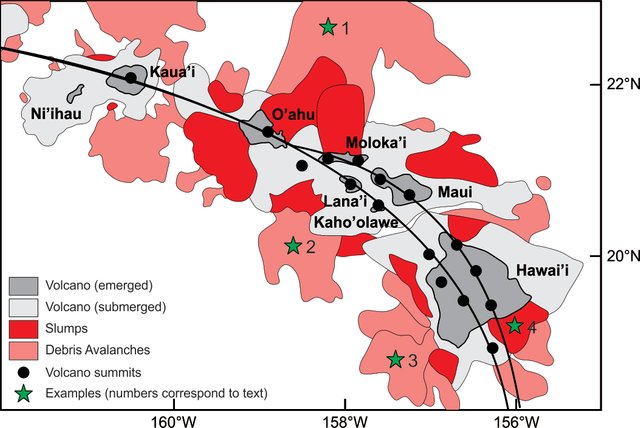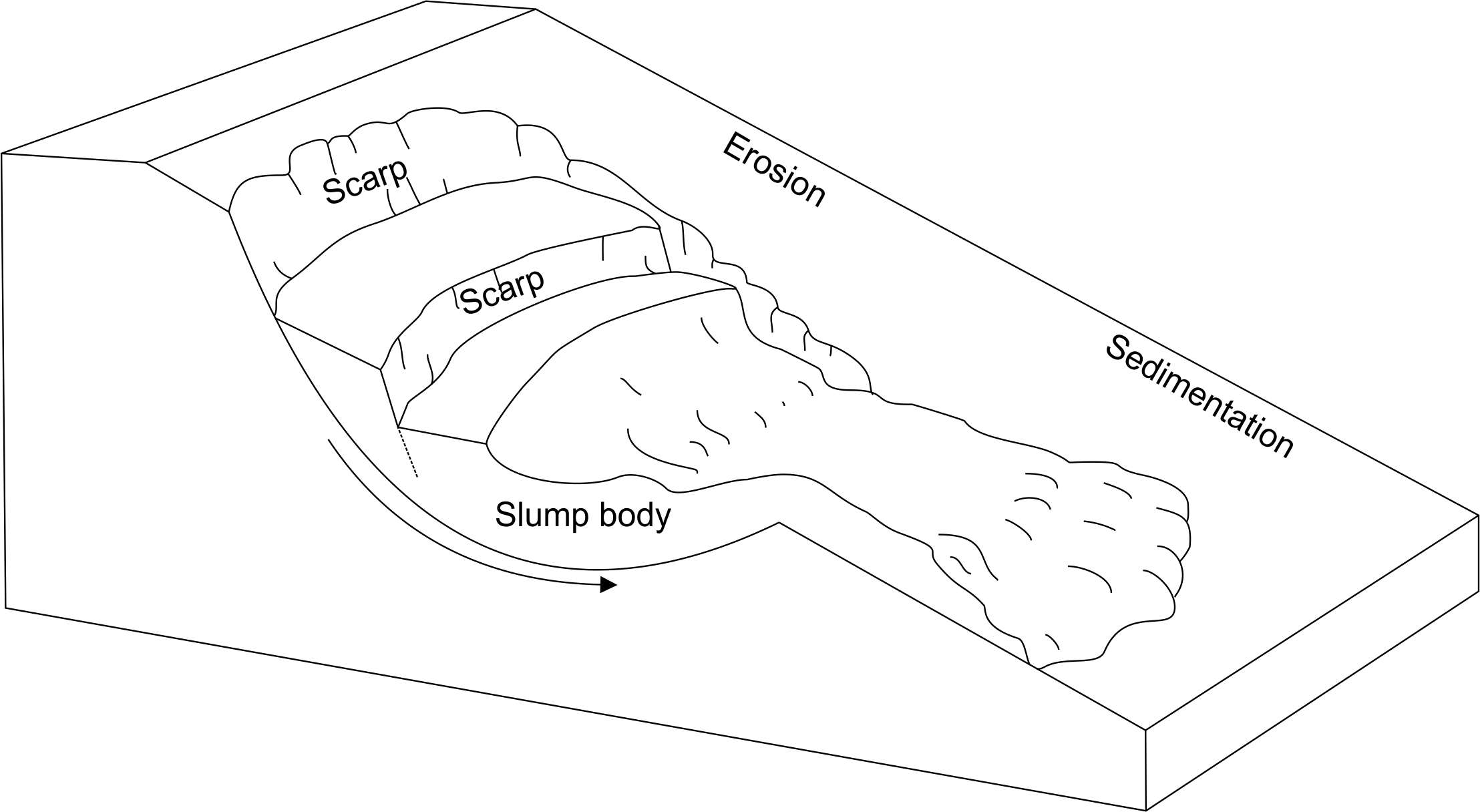Hawaiian volcanoes - Part 11: Volcanoes falling apart... from Landslides and Tsunamis
While a Hawaiian volcano grows, it develops the beautiful shield like shape, with gently sloping flanks. On the edges of the Hawaiian Islands, this image changes. Here, the landscape is dominated by steep scarps, forming spectacular cliffs on land or beneath the ocean surface.

Molokai coastline from the air.
flickr.com
The hazards at hand
Scarps (pali in Hawaiian) are eroded faults at which large boulders slipped of the sides of the volcanoes and dropped violently into the ocean, causing landslides on land and under water. Submarine landslides push away ocean water and create tsunamis. This describes an often overlooked hazard that volcanoes pose, the fact that they can stay dangerous, even after they are no longer active. Older Hawaiian volcanoes literally fall apart.
The resulting landslides and related tsunamis have devastating effects on the coastal areas and the locals.
Hawaiian landslides
The USGS has identified over 70 major landslides that are over 20 km in long on the ridges of Hawaiian volcanoes [1] Some of the landslides are over 200 km long and exceed volumes of 5000 km3. They are among the largest on the planet.
Two types of landslides are documented around the Hawaiian Islands. Slumps and debris avalanches [2], with various intermediate compositions. Generally, slumps descend on slopes greater than 3° and debris avalanches on slopes shallower than 3°.
Slumps move while leaving the broken off pieces of the volcano flanks largely intact, reaching thicknesses of 10 km. The majority of the time they move slowly but infrequently surge forward abruptly. This causes large earthquakes, including the largest ones in Hawaiian history.
Debris avalanches are highly fragmenting the volcanic material they are composed of, creating smaller debris. They move much more rapid, creating thinner and longer deposits than slumps. At their end they form a nice arc of sediment. Rapidly moving avalanches that carry large boulders create shock forces on the water column that create giant tsunamis [3].

Map of the Hawaiian Islands with submarine extension of volcanic surface, as well as slump and debris avalanche distribution. Volcanic centers are indicated as black dots. For details on the examples please see text.
Modified after Moore et al. (1994)
Examples
Example 1:
About 1.95-2.15 million years ago, on the northeastern coast of O'ahu huge blocks (>10 km) of flank of the Ko’olau volcano sheared off in a sudden landslide [4]. The debris was carried several hundred kilometers offshore and left spectacular cliffs up to 700 m high known as the Ko’olau Range.
Ko’olau Range on O'ahu.
commons.wikimedia.org
Example 2
105,000 years ago, a large block ripped off the flank of Lana'i [5]. The resulting slide was up to 40 km thick and travelled more than 70 km along the volcanos flank. It created a series of large waves that devastated the south coast of Lanai. The waves crashed more than 375 meters into the island carrying with them coral fragments and pieces of ocean floor. On their way back they scraped over the ground ripping every piece of vegetation or lose sediment with them and leaving only barren rock. Interestingly, even on the northern side of Lanai, wave deposits can be found up to 100 m land inwards. This shows that tsunamis are able to wrap around masses of land and are able to devastate the coast of complete islands.
Example 3
Slides on the Big Island occur on the western flank of Mauna Loa. Here individual lobes of debris avalanches traveled as far as 100 km, with volumes exceeding 600 km3. All landslides on the western flank of Hawai’i together exceed 2,000 km3. The lobes were violently detached from the flanks of Mauna Loa causing the rapid slide events and tsunamis [6].
Example 4
On the other side of the island the sliding mechanisms are different. At the south flank of Kīlauea the giant Hilina slump is constantly moving southwards [7, 8]. It moves slowly with an average speed of 10 cm a year, leaving the slices of volcano flanks largely intact. Rapid jumping of these blocks can cause earthquakes and tsunamis, like it did in 1975.

Schematic diagram of a rotational landslide, like the Hilina slump.
Modified after Varnes (1978)
Example 5
Instead of triggering earthquakes themselves, giant slides can also be triggered by earthquakes. Several incidents have been observed where earthquakes loosened large slabs of rocks from the flanks of volcanoes. One of them was an earthquake in April of 1868 that caused a landslide that buried a complete village, killing 31, and resulted in a tsunami, killing additional 46 people [9].
Ties to Hawaiian Mythology
William Drake Westervelt passed down the Hawaiian legend “A Giant’s Rock-Throwing” [10] that shows how the movement of large rock masses and birth of tsunamies ties into the belief of the Hawaiian natives.
The point of land on the northwetern coast of the island O’ahu is called Ka-lae-o-Kaena, which means “The Cape of Kaena”. In the ocean infront of this cape lies a large rock. It bears the name Pohaku-o-Kauai, the “Rock of Kaua'i, a large island just northwest of O’ahu. The rock has the size of a small house. On the island of Kaua'i resided a powerful warrior demigod, named Hau-pu.
One night Hau-pu was awoken by loud noises coming from the ocean. A chief from O’ahu had assembled a fishing party. Hau-pu however mistook the boats for a warrior party coming from O’ahu. He tore a huge rock from its place and hurled it towards the assumed intruders. The boulder flew high through the air landing with incredible speed in the centre of the fishing party. Many of the fishermen perished. Among them the chief, whose name was Kaena. The striking boulder caused huge waves that hurtled towards O’ahu. Upon hitting the land the waves deposited large amounts of sand that formed a long point of land. The survivors of the event named it the Cape of Kaena, in honor of their deceased chief. The boulder itself was imbedded deeply into the ocean bed and only its head is peaking out of the water. Here it lies ever since, given the name “Rock of Kaua'i”.
In general, if we compare the two sisters that shape Hawaiian mythology, Pele and Nā-maka-o-Kahaʻi, the goddess of the sea seems to be the more destructive. Her tsunamis sometimes crash ashore without warning, having devastating effects on the coastal areas of Pele’s realm. Her constant efforts to destroy her sisters constructs have been acknowledged ever since and will continue to cause great harm to the people of Hawai’i.
Tsunamis in the bigger Picture
The location of the Hawaiian Islands in the centre of the Pacific generates more widespread tsunami problems. Tsunamis generated at Hawai’i cannot only have devastating effects on the islands themselves but can travel afar and have impacts on the coastlines all around the Pacific Ocean. Additionally, tsunamis origination anywhere else in the Pacific Ocean have the potential to hit Hawaii. Extensive convergent plate boundaries surround the Pacific plate, which generate high-magnitude earthquakes that set up huge tsunamis. These tsunamis cause great damage at Hawai’i.
The Pacific Tsunami Warning Center alerts the Hawaiian Islands in advance if tsunamis from elsewhere in the Pacific are heading for the islands. A tsunami that originates on the Hawaiian Islands itself is hitting immediately and leaves no time for evacuation, therefore causing the greatest threat.
Previous Posts
Hawaiian volcanoes - Part 1: Introduction
Hawaiian volcanoes - Part 2: The Hawaiian Hotspot
Hawaiian volcanoes - Part 3: A growing volcano
Hawaiian volcanoes - Part 4: The Rejuvenation Stage
Hawaiian volcanoes - Part 5: Evolution to Atolls and Seamounts
Hawaiian volcanoes - Part 6: Mythology vs Geology
Hawaiian volcanoes - Part 7: Recent eruptions
Hawaiian volcanoes - Part 8: Volcano Monitoring
Hawaiian volcanoes - Part 9: Predicting Eruptions
Hawaiian volcanoes - Part 10: Volcanic Air Pollution
References
[1] Moore, J.G., Normark, W.R., Holcomb, R.T. (1994). Giant Hawaiian Underwater Landslides. Science 264, 46-47.
[2] Moore, J.G., Clague, D.A., Holcomb, R.T., Lipman, P.W., Normark, W.R., Torresan, M.E. (1989). Podigious Submarine Landslides on the Hawaiian Ridge. Journal of Geophysical Research 94, 17,465-17,484.
[3] Moore, G.W. and Moore, J.G. (1988). Large-scale bedforms in boulder gravel produced by giant waves in Hawaii. Geological Society of America Special Papers 229, 101-110.
[4] Herrero-Bervera, E., Cañon-Tapia, E., Walker, G.P.L., Guerrero-Garcia, J.C. (2002). The Nuuanu and Wailau giant landslides: insights from paleomagnetic and anisotropy of magnetic susceptibility (AMS) studies. Physics of the Earth and Planetary Interiours 129, 83-98.
[5] Johnson, C., Mader, C.L. (1994). Modeling of the 105 ka Lanai tsunami. Science of Tsunami Hazards 12, 33-38.
[6] McMurtry, G.M., Watts, P., Fryer, G.J., Smith, J.R., Imamura, F. (2004). Giant landslides, mega-tsunamis, and paleo-sea level in the Hawaiian Islands. Marine Geology 203, 219-233.
[7] Moore, J.G. and Clague, A. (1992). Volcano growth and eolution of the island of Hawaii. Geological Survey of America Bulletin 104, 1471-1484.
[8] Smith, J.R., Malahoff, A., Shor, A.N. (1999). Submarine geology of the Hilina slump and morpho-structural evolution of Kilauea volcano, Hawaii. Journal of Volcanology and Geothermal Research 94, 59-88.
[9] https://www.shakeout.org/hawaii/downloads/Earthquakes_in_Hawaii.pdf
[ ] https://en.wikipedia.org/wiki/William_Drake_Westervelt
[10] Westervelt, W.D. (2011). Hawaiian Legends of Ghosts and Ghost-Gods. BiblioLife, 214 p.
[ ] http://ptwc.weather.gov/
- https://www.flickr.com/photos/james_brennan/8675495591
- Varnes, D.J. (1978). Slope movement types and processes. In: Schuster, R.L., Krizek, R.J. (Eds.), Landslides, Analysis and Control, Special Report 176. National Academy of Sciences, Washington, DC, 11–33.
You received a 80.0% upvote since you are a member of geopolis and wrote in the category of "geopolis".
To read more about us and what we do, click here.
https://steemit.com/geopolis/@geopolis/geopolis-the-community-for-global-sciences-update-4
It's like the US stock market crash!
Cool! Eruptions build them up. Gravity takes them down...
Nice article! The magnitude of these landslides is incredible...Hawai'i is more dangerous than I realized.
i had a lot of pleasure in reading your post. I traveled to Hawaii like 10-11 years ago, and I can really remember the pictures of that trip illustrating your text! Thanks for writing it!
I really hope to sometime be able to get there myself. It seems like a magical place. And when imagining walking an active lava flow, the little kid in me emerges.
I witnessed lava flowing in the ocean during the night, from a boat. This is both impressive and magical. I you had the opportunity to go there, just don't hesitate. I have unfortunately recently learned that the prices have skyrocketed compared with 10 years ago. Tourism is popular... :(
I would love to see that. I actually have a foto of exatly one of those events hanging in my living room.
I have looked into prices and if you restrict yourself to one island you can get some cheap trips last minute. But the full Hawaii adventure is out of my price range at the moment.
From Europe, I think you need already to put 1.5 kEUR on the table just to fly there. But I have not carefully checked as well as this is above my current vacation budget as well :/
Yeah, from Ottawa you can get flights to one of the 'non-main' islands for a little less than 600CAN$. Which would make a very nice vacation, but it means no active volcano...
And of course you need to add the lodging costs plus the food, which is not negligible in a place living from tourism. I may pay you a visit in Ottawa instead! Much more affordable ;)